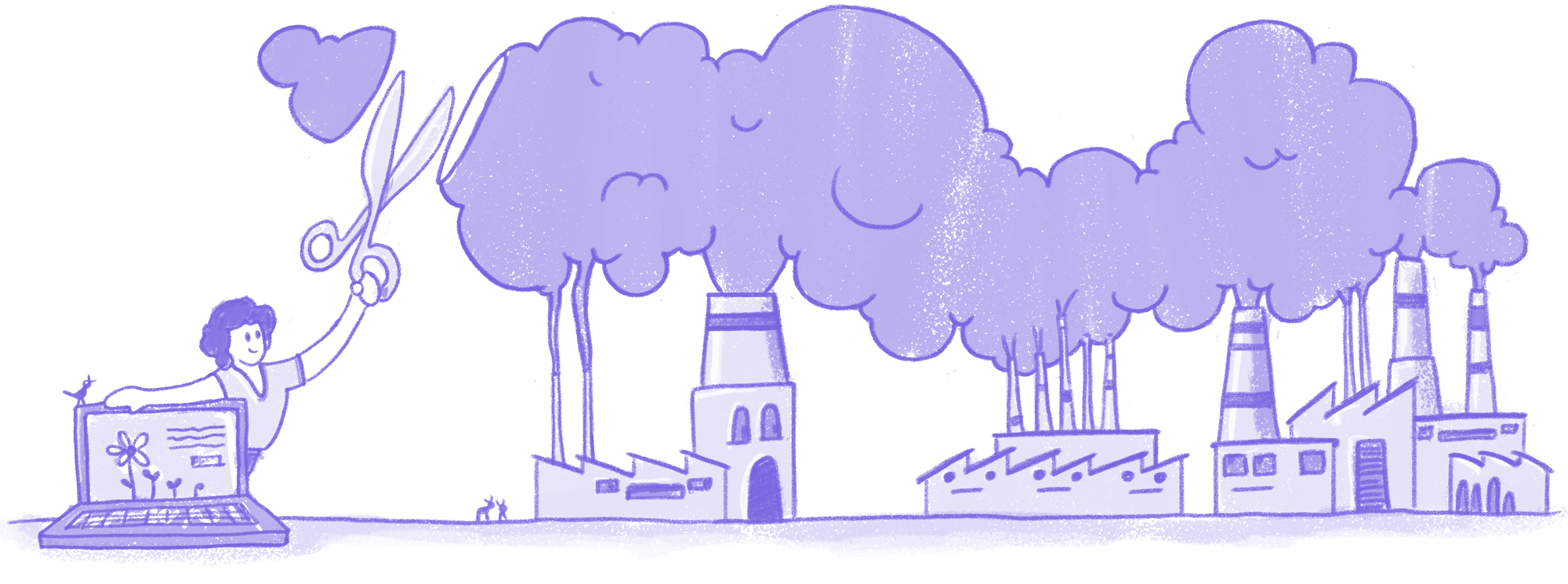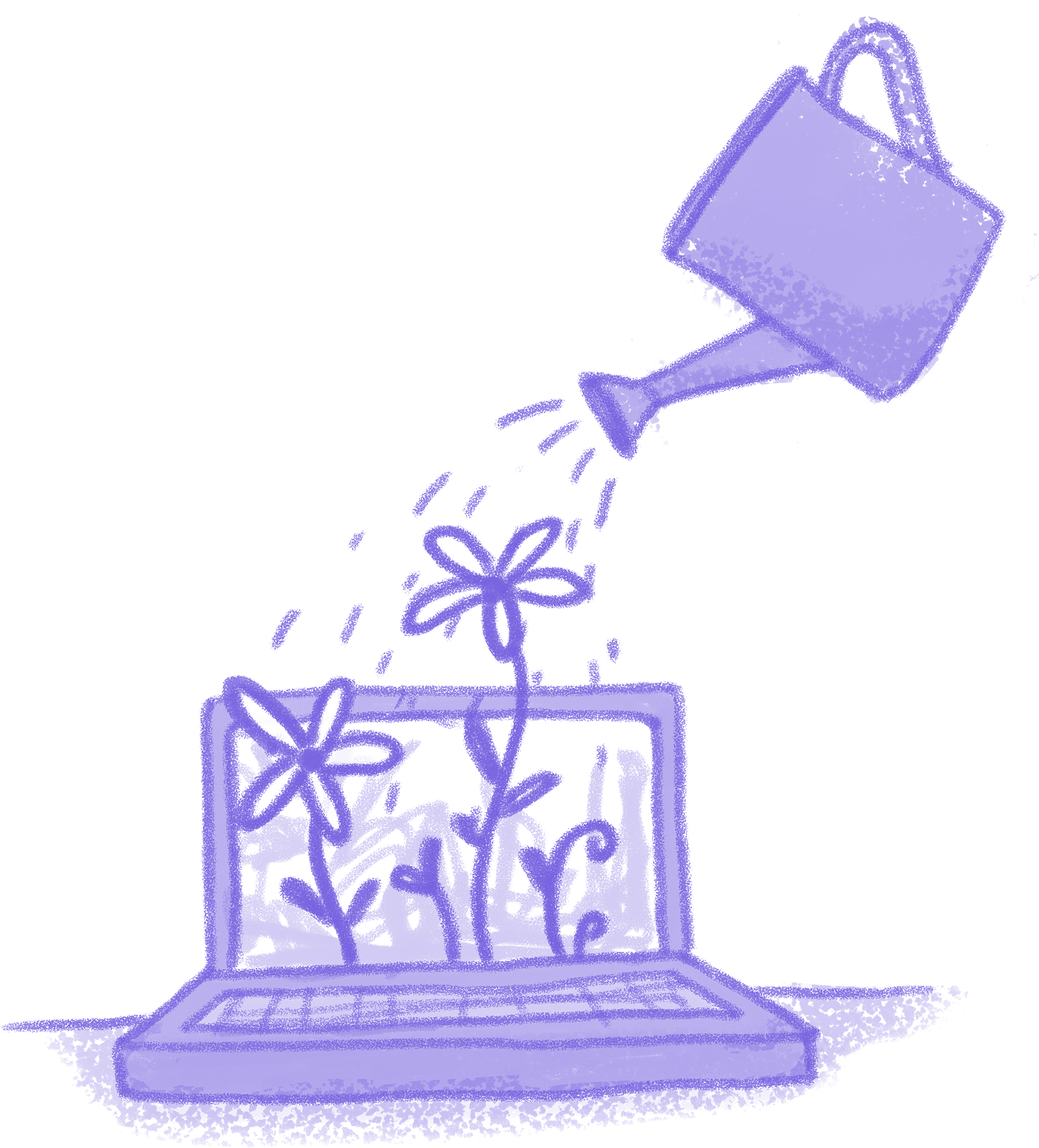Click by Click to Sustainability
A brief overview of the ecological, economic, and social potential of websites
You can find the original post in German on my website: www.launch-point.de/klick-fuer-klick-nachhaltig
If you have feedback, comments, additional insights, or ideas, or if you need support for your project, I’d love to hear from you.
When we talk about sustainability, we think of electric cars, solar panels, and vegan diets. But the internet?
Many people are still unaware that websites leave a significant ecological footprint. For a long time, they were considered a green alternative to print media and the physical routes to stores, offices, or administrative buildings. It’s only with the recent AI hype that attention has shifted to the energy consumption of digital infrastructures.
However, the impact of digital media on sustainability is more complex. It affects not only the environment but also plays a crucial role in the social and economic dimensions—making it highly relevant to achieving the Sustainable Development Goals (SDGs).
So, which aspects should be considered? And what sustainability potentials can you leverage in the design and operation of your website?
The Sustainability Potential of Your Website
You can measure your website’s CO₂ footprint, for example, at www.websitecarbon.com. At first glance, the impact of a single website may seem minimal. However, it is the sum of all small and large efforts that contributes to operating digital infrastructures in a resource-efficient way—turning the internet into a valuable and sustainable platform.
Five key areas to optimize:
1. Concept & Planning
Structure and Usability
A well-thought-out, clear information architecture and intuitive navigation are crucial. Every unnecessary interaction that can be avoided saves energy. Users can quickly find what they need without frustration. And the better the user experience, the greater and more constructive your impact.
Goal-Oriented Content
A user-centric website addresses the needs of its audience by providing clear and relevant content—text, images, and media. The sustainability connection might not be obvious, but it’s relevant: clear and accessible content reduces internet time and clicks, which in turn lowers emissions. Efficient media usage ensures that loading a website doesn’t consume more energy than necessary.²⁴
Content Lifecycle Management
Regularly update and clean up your content. Remove outdated or irrelevant information to avoid "data clutter" that consumes storage space and energy.
2. Communication
Focus
Always keep your values, vision, and goals in mind.
Authenticity and Integrity
Be honest and authentic. Use transparent terms of service, user-friendly and understandable interactions, and maintain an ethical approach to your users. Sustainability is hardly compatible with methods like clickbait or manipulative techniques such as sludging.
Good Communication Culture
Communicate clearly and in a way that resonates with your target audience. Use infographics, explainer videos, and storytelling to convey complex content effectively.
Consider multiple perspectives and ensure respectful, inclusive language. Criticism is easy, but only constructive criticism leads to progress.
Avoid inflammatory language, hate speech, or fear-mongering. Sensational headlines may attract attention but distort perceptions. Balanced and authentic communication—including positive messages—builds trust.
Provide users with actionable solutions and encourage them to take initiative. The opportunity to contribute and experience self-efficacy creates positive emotions and strengthens their connection to your brand.³⁰ ³¹
Fake News
Misinformation is a serious problem. Verify your sources and cite them transparently.
Diversity and Inclusion
Ensure that your communication is inclusive and respectful of diversity. Gender-sensitive and culturally aware language builds trust and demonstrates appreciation.
Interaction and Engagement
Encourage user interaction, for example, through feedback options. This strengthens engagement and provides valuable insights into their needs and preferences.
Data Protection and Security
Data is valuable. Handle it responsibly, be transparent about its usage, and collect only what is necessary.
3. Design
Color Choice
Dark mode designs save energy on OLED displays (which many smartphones use). Interestingly, the blue LED in the RGB spectrum consumes about 25% more energy than red and green—a factor that can be relevant for large web projects.²⁵ ²⁶
Typography
The fewer fonts that need to be loaded, the less energy is consumed when loading a website. The most energy-efficient option is to use system fonts—fonts that are already installed on users’ devices. Since this is often impractical, limiting the number of fonts to two or three ensures a clear, consistent design while reducing resource usage.
Media Selection
Fewer images and videos in smaller sizes or lower resolutions reduce the energy consumption of your website. Simple illustrations and vector graphics require less energy than photos, videos, or animated GIFs when loading a webpage.²⁴
Ethical Web Design
Avoid dark patterns—manipulative design practices that trick users into unintended actions.
Ensure accessibility in the design phase so that your website is usable for everyone.
4. Technical Implementation
Accessibility
Ensure your website is accessible to all. An inclusive design is socially sustainable and is also rewarded with better SEO rankings.
Fonts
Self-hosted fonts and variable fonts reduce data volume and loading times.
Image and Video Compression
Use modern formats like WEBP or SVG and compression tools to minimize media file sizes.
Upload images in the required dimensions rather than oversized files. Large media like videos should initially load in low quality, with higher-quality options available on demand.
Lazy Loading
Lazy loading ensures that media is only loaded when users need it or scroll to it—saving resources.
Efficient Code
A lean, well-structured codebase that includes only essential scripts reduces energy consumption and improves loading times.
Avoid Unnecessary CMS, Plugins, and Themes
If using a CMS like WordPress or Typo3, avoid unnecessary plugins and themes. For small projects, consider using static websites, which are significantly more resource-efficient.
Mobile First
Develop your website primarily for smartphones. This prevents the unnecessary loading of large media files and eliminates redundant style adjustments for larger screens.
Page Speed
A faster-loading page processes fewer data and code, saving energy while improving SEO and user experience.
Updates and Technological Innovations
Stay up to date and implement sustainable technologies like Progressive Web Apps (PWAs) or Accelerated Mobile Pages (AMP). However, always assess new trends for their actual effectiveness and efficiency.
5. Hosting
Renewable Energy
Choose a hosting provider that operates entirely on renewable energy. CO₂ offsetting is only meaningful if it compensates for truly unavoidable emissions.
Efficient Energy Use
Eco-friendly data centers use efficient cooling systems and repurpose waste heat for building heating. A smart infrastructure further conserves energy.
Sustainable Hardware Practices
Sustainability in hardware means repair, reuse, and recycling. Ensure your hosting provider follows these principles. If unclear, ask for transparency.
Local Proximity
Choose data centers close to your primary user base to reduce energy consumption in data transmission. For globally distributed users, Content Delivery Networks (CDNs) help efficiently distribute data.
Shared Hosting
Shared hosting, where multiple users share a server, is a more resource-efficient option.
Maintenance and Security
Regularly maintain your servers and keep your software, such as PHP, up to date. Excluding unnecessary bots also helps save resources.²⁷ ²⁸
The development, maintenance, and hosting of your website significantly influence its CO₂ footprint, which you can measure at www.websitecarbon.com.
Beyond energy consumption, websites shape opinions, influence consumer behavior, and drive decisions. Be aware of this responsibility and use it positively to promote sustainable values.
Sustainability Pays Off
A sustainably designed website offers numerous benefits: It improves performance, reduces costs, and positions you as a responsible company. Fast loading times and efficient code enhance the user experience and lower bounce rates. At the same time, you demonstrate that sustainability is part of your brand—building trust and attracting new customers.
Sustainability is not just good for the environment; it’s also good for business.
Relevance for Achieving the SDGs
Websites have become an integral part of both our private and professional lives. They can help advance the Sustainable Development Goals (SDGs)—from environmental issues and social justice to economic transformation. A consciously designed and sustainably operated website creates opportunities for positive change. However, this is only possible if emissions, resource consumption, and rebound effects are carefully considered and responsibly managed.
Ecological Aspects
Every interaction on the internet consumes energy. Every click, every page load requires electricity. According to The Shift Project¹, the internet’s annual CO₂ emissions are equivalent to those of a mid-sized industrial country and have already surpassed the emissions from air travel.
The problem is not just the resource consumption of data centers but also the environmental and social exploitation involved in manufacturing and disposing of the necessary hardware² ³ ⁴. Most users never see this impact.
Additionally, the internet drives consumption and resource use, whether through increased data traffic from streaming services or the sharp rise in online shopping, which generates more packaging waste and requires additional transport. This development is closely tied to the internet’s success⁵ ⁶.
Despite its negative effects, websites also contribute positively to the environment. They provide access to education, information, and networking opportunities, support monitoring and reporting efforts (SDG 13: Climate Action), and enable dematerialization by replacing physical production, storage, and transportation²².
Social Aspects
The internet offers many opportunities to improve societal participation. Websites facilitate access to education, economic opportunities, and healthcare, empower minority communities, and provide information without reliance on traditional gatekeepers like publishers. This means online platforms can significantly contribute to achieving multiple global sustainability goals⁷ ⁸.
However, websites do not solely create positive societal change—they also pose risks. They can manipulate public opinion⁹ ¹⁰ and encourage questionable consumer behavior¹¹ ¹² ¹³ ¹⁴ ¹⁵.
Economic Aspects
Digitalization—and websites in particular—provide businesses with significant economic advantages. They reduce material and production costs for information and marketing materials, cut storage and logistics costs via online shops, and lower personnel expenses through automation and streamlined digital processes¹⁶ ¹⁷ ¹⁸ ¹⁹.
Websites are highly scalable: Whether reaching more users or expanding globally, the digital world enables growth at a fraction of the cost of a physical infrastructure. This is especially advantageous for digital products such as subscriptions or services. Additionally, their flexibility offers even more opportunities for economic expansion. These benefits lower barriers to entry for entrepreneurs and increase economic efficiency²⁰ ²¹.
Thus, from an economic perspective, websites have the potential to contribute to global sustainability goals, such as SDG 8: Decent Work and Economic Growth²² ²³.
Best Practice Examples of Sustainable Websites
These examples demonstrate that sustainable web design is not only possible but also successful.
Low←Tech Magazine
Low←Tech Magazine not only explores resource-saving solutions in its content but also implements them directly by hosting its website on a solar-powered server. The site is deliberately minimalist, featuring a monochrome, pixel-based design and avoiding energy-intensive images.
🔗 solar.lowtechmagazine.com
Organic Basics
Danish fashion brand Organic Basics offers a low-impact version of its website, which is designed and optimized for minimal resource consumption. By reducing or compressing large images and videos, the site significantly lowers energy usage, demonstrating how a brand can integrate its values into every aspect of its business.
🔗 organicbasics.com
Branch Magazine
Branch Magazine is a low-impact website dedicated to promoting sustainability in the digital space. The site uses simple layouts and highly compressed images to minimize energy consumption. It is also powered by solar energy and follows a resource-efficient programming approach to reduce CO₂ emissions.
🔗 branch.climateaction.tech
Conclusion
Your website and online presence are not just economically relevant for your business—they also present an opportunity to operate sustainably. Communicating complex topics or providing interactive and participatory tools requires space and sometimes resource-intensive web features. That’s fine if they offer real value in the end. The goal is not to create the most sustainable website in the world but to use resources effectively and consciously.
Sustainability is an ongoing process without a one-size-fits-all solution. By focusing on intelligent concepts, clear communication, and interdisciplinary collaboration, we can create new paths toward a sustainable digital future.
This article aims to highlight the sustainability potential of websites, offer solutions, and inspire action. If you want to dive deeper into sustainability communication or make sure you don’t miss future insights on branding, communication strategies, and sustainable brand communication, subscribe to my newsletter or follow me on LinkedIn or Instagram.
If you have feedback, comments, additional insights, or ideas, or if you need support for your project, I’d love to hear from you.
Thanks for reading Substack von LaunchPoint. Subscribe for free to receive regular insights on strategic branding and communication in the field of sustainability :
Are you looking for an expert in brand building, sustainability communication, or communication strategy? Feel free to reach out—I’d be happy to discuss how we can work together. If you’d like to learn more about me and my work, visit my website.
Sources:
1. The Shift Project: „Lean ICT – Towards Digital Sobriety“: https://theshiftproject.org/en/article/lean-ict-our-new-report/
2. Andrae, A. S. G., & Edler, T. (2015). On Global Electricity Usage of Communication Technology: Trends to 2030.: https://www.mdpi.com/2078-1547/6/1/117/pdf
3. Höfner, Anja & Frick, Vivian. (2019). Was Bits und Bäume verbindet. Digitalisierung nachhaltig gestalten.: https://www.germanwatch.org/sites/germanwatch.org/files/Was%20Bits%20%26%20Bäume%20verbindet%20-%20Buch.pdf
4. Forti, V., Baldé, C. P., Kuehr, R., & Bel, G. (2020). Quantities, Flows and the Circular Economy Potential. United Nations University, UNITAR & International Telecommunication Union.: https://ewastemonitor.info/wp-content/uploads/2020/11/GEM_2020_def_july1_low.pdf
5. UNCTAD (2020). COVID-19 and E-Commerce: A Global Review. United Nations Conference on Trade and Development (UNCTAD): https://unctad.org/publication/covid-19-and-e-commerce-global-review
6. Cohen, M. J. (2020). Does the COVID-19 Outbreak Mark the Onset of a Sustainable Consumption Transition?: https://www.frontiersin.org/journals/environmental-science/articles/10.3389/fenvs.2022.953907/full
7. World Economic Forum. (2020, September 23). How greater digital cooperation can help achieve the SDGs. World Economic Forum. https://www.weforum.org/agenda/2020/09/sdi20-united-nations-sdg-digital-cooperation/
8. World Economic Forum. (2020, September 23). How greater digital cooperation can help achieve the SDGs. World Economic Forum. https://www.weforum.org/agenda/2020/09/sdi20-united-nations-sdg-digital-cooperation/
9. United Nations Development Programme. (n.d.). Countering misinformation and disinformation in the crisis setting. United Nations Development Programme. https://www.undp.org/eurasia/dis/misinformation
10. Chaturvedi, S. (2023). How to cut the environmental costs of online shopping. Nature, 621(7976), 610–612. https://doi.org/10.1038/d41586-024-01587-3
11. Environmental Defense Fund. (2021, December 20). Why the e-commerce supply chain has a big environmental footprint and how companies can reduce it. EDF+Business. https://business.edf.org/insights/why-the-e-commerce-supply-chain-has-a-big-environmental-footprint-and-how-companies-can-reduce-it/
12. David Suzuki Foundation. (n.d.). Unpacking online shopping’s environmental impacts. David Suzuki Foundation. https://davidsuzuki.org/living-green/unpacking-online-shoppings-environmental-impacts/
13. World Economic Forum. (2020, January 16). How much CO2 does online shopping send into the air? And how can we reduce it? World Economic Forum. https://www.weforum.org/agenda/2020/01/carbon-emissions-online-shopping-solutions/
14. Earth.Org. (2023, July 4). Online shopping and its environmental impact. Earth.Org. https://earth.org/online-shopping-and-its-environmental-impact/
15. Lee, S. (2022, January 24). Online shopping is destroying the environment. The Science Survey. https://thesciencesurvey.com/editorial/2022/01/24/online-shopping-is-destroying-the-environment/
16. Muro, M., Maxim, R., & Whiton, J. (2020, November 13). How digital transformation is driving economic change. Brookings Institution. https://www.brookings.edu/articles/how-digital-transformation-is-driving-economic-change/
17. Köhler, B., Clauss, T., & Eggers, F. (2023). A business model perspective on sustainable digital entrepreneurship: Pathways toward a research agenda. Review of Managerial Science. https://doi.org/10.1007/s11846-023-00647-8
18. Shi, Y., Liu, Z., Chen, Q., & Yu, H. (2023). Environmental impacts of online shopping: A systematic review and research agenda. PLOS ONE, 18(7), e0302133. https://doi.org/10.1371/journal.pone.0302133
19. Goldfarb, A., & Tucker, C. (2020). The economics of digitization. NBER Reporter, (2). https://www.nber.org/reporter/2020number2/economics-digitization
20. Moro-Visconti, R. (2022). Digital Scalability and Growth Options. In: The Valuation of Digital Intangibles. Palgrave Macmillan, Cham. https://doi.org/10.1007/978-3-031-09237-4_3
21. Jin Zhang, J., Lichtenstein, Y. and Gander, J. (2015), „Designing Scalable Digital Business Models“, Business Models and Modelling (Advances in Strategic Management, Vol. 33), Emerald Group Publishing Limited, Leeds, pp. 241-277. https://doi.org/10.1108/S0742-332220150000033006
22. van Niekerk, A.J. Inclusive Economic Sustainability: SDGs and Global Inequality. Sustainability 2020, 12, 5427. https://doi.org/10.3390/su12135427
23. Kulkarni, S. (2024). Editorial: Global Sustainability: Trends, Challenges, and Case Studies. In: Kulkarni, S., Haghi, A.K. (eds) Global Sustainability. World Sustainability Series. Springer, Cham. https://doi.org/10.1007/978-3-031-57456-6_1
24. The Shift Project. (2019, July 15). Unsustainable use of online video. The Shift Project. https://theshiftproject.org/en/article/unsustainable-use-online-video/
25. Pranab Dash and Y. Charlie Hu. 2021. How much battery does dark mode save? An Accurate OLED Display Power Profiler for Modern Smartphones. In The 19th Annual International Conference on Mobile Systems, Applications, https://dl.acm.org/doi/pdf/10.1145/3458864.3467682
26. LowSpecGamer. (2023, March 1). The cost of a pixel color: Deep dive into rendering.
27. Kinsta. (2023, August 14). PHP versions: What they are and why you should update. Kinsta. https://kinsta.com/blog/php-versions/#why-you-should-update-php-versions
28. Hayden, S. (2023, September 21). Bad bots make up a fifth of all web traffic in 2023. Infosecurity Magazine. https://www.infosecurity-magazine.com/news/bad-bots-make-up-a-fifth-of-all/
29. Singh, S. (2020). Impact of digital marketing on consumer behaviour. Inspira- Journal of Modern Management & Entrepreneurship (JMME), 10(4), 112-115. https://www.inspirajournals.com/uploads/Issues/1289350542.pdf
30. Yan, L., Keh, H.T. & Murray, K.B. Feeling the values: How pride and awe differentially enhance consumers’ sustainable behavioral intentions. J. of the Acad. Mark. Sci. 52, 75–96 (2024). https://doi.org/10.1007/s11747-023-00928-4
31. Doménech, P.; Tur-Porcar, A.M.; Mestre-Escrivá, V. Emotion Regulation and Self-Efficacy: The Mediating Role of Emotional Stability and Extraversion in Adolescence. Behav. Sci. 2024, 14, 206. https://doi.org/10.3390/bs14030206







